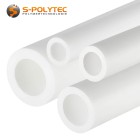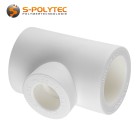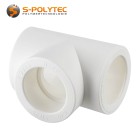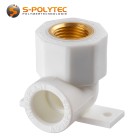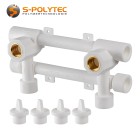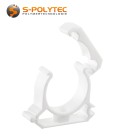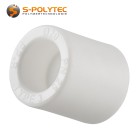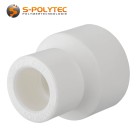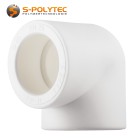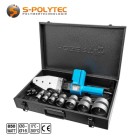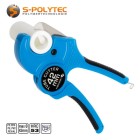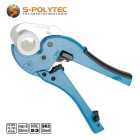
Aqua-Plus PP-R pipes and fittings for pipeline construction
Our innovative Pipe power system Aqua-Plus made of polypropylene ramdom copolymer is a durable, low-cost alternative to conventional pipelines made of metal and is characterised by very simple processing.
- We offer Aqua-Plus PP-R pipes suitable for drinking water in various diameters as standard length
- In addition to the PP-R pipes, we also stock matching pipe connectors, fittings, end caps, branch and reducer pieces.
- As a complete system, our range also includes PP-R couplings, stopcocks, ball valves and assembly material
Aqua-Plus PP-R pipes in white
 from €2.90 /
from €2.90 /Incl. 19% Tax
Aqua-Plus PP-R T-reducer in white
 from €0.84 /
from €0.84 /Incl. 19% Tax
Aqua-Plus PP-R T-piece in white
 from €0.65 /
from €0.65 /Incl. 19% Tax
Aqua-Plus PP-R wall connection angle 90° in white
 €3.30 / pcs
€3.30 / pcsIncl. 19% Tax
Aqua-Plus PP-R mounting unit for wall-mounted fittings in white
 €9.70 / pcs
€9.70 / pcsIncl. 19% Tax
Aqua-Plus PP-R tube clip in white
 from €0.15 / pcs
from €0.15 / pcsIncl. 19% Tax
Aqua-Plus PP-R socket in white
 from €0.55 / pcs
from €0.55 / pcsIncl. 19% Tax
Aqua-Plus PP-R reducing socket in white
 from €0.80 / pcs
from €0.80 / pcsIncl. 19% Tax
Aqua-Plus PP-R Angle 90° in white
 from €0.75 / pcs
from €0.75 / pcsIncl. 19% Tax
Socket welder 850W in case (for pipes Ø 16mm - Ø 63mm)
 €69.90 / pcs
€69.90 / pcsIncl. 19% Tax
Professional pipe cutter for plastic pipes up to Ø 42mm
 €18.90 / pcs
€18.90 / pcsIncl. 19% Tax
Pipe cutter ERGO Grip for plastic pipes up to Ø 42mm
 €14.90 / pcs
€14.90 / pcsIncl. 19% Tax
Aqua-Plus - the innovative piping system made of PP-R
Easy processing ✓ Over 50 years service life ✓ Suitable for drinking water ✓
The Aqua-Plus piping system made of high-quality polypropylene ramdom copolymer is an inexpensive alternative to conventional line pipes and is characterised by a whole range of positive aspects. In addition to the lower purchase price for the individual components, the processing time also represents a saving. Furthermore, no expensive special tools are required to make water- and pressure-tight connections. The socket welding equipment needed for the so-called fusion welding of pipes and fittings is already available from around 30 euros.
The special form of polypropylene, which is characterised by a higher impact strength, is one of the polyolefin thermoplastics. This is an extremely durable material that exhibits high strength even at high temperatures, even under internal pressure, which is why pipe systems made of PP-R are suitable for a wide variety of applications.
We offer the right components of the Aqua-Plus PP-R pipe system for all requirements!
Aqua-Plus PP-R pipes are versatile and can be used for a wide range of applications thanks to countless system components. For example, the pipes are excellently suited for drinking water supply, for targeted garden irrigation or as supply lines for air conditioning and heating systems. In addition, the Aqua-Plus PP-R system can also be used in pool construction for supply lines of fresh water and hot water. The chlorinated water usually contained in swimming pools cannot harm the chemically very resistant polypropylene. For the same reason, the PP-R pipes are also used as transport pipes for chemical liquids in various branches of industry.
All available components of the Aqua-Plus pipe system are perfectly matched.
The individual system components that we offer in our online shop are as versatile as the possible applications of the Aqua-Plus pipe system. From pipes and simple pipe connectors, the so-called sleeves or fittings, our delivery programme also includes reducers, branch sleeves and end caps. Couplings for mounting taps and fittings, as well as stopcocks and ball valves, are also part of our standard range. Unlike most other suppliers who stock the Aqua-Plus system in green, we offer all components in neutral white. However, the more neutral colour has no effect on the technical and chemical properties, so it only results in a more pleasant appearance for surface-mounted installations and is less conspicuous in contrast to the green pipe.
Our delivery programme for the Aqua-Plus piping system
- Aqua-Plus PPR pipes PN25 in white in diameters from 20mm to 40mm in 2 metre lengths
- Aqua-Plus PPR couplers PN25 in white for connecting PPR pipes with the same pipe diameter
- Aqua-Plus elbow PN25 in white optionally with 45° or 90° elbow for our Aqua-Plus PPR pipes
- Aqua-Plus T-pieces and T-pieces with reducer in different versions in white
- Aqua-Plus PPR reducing couplings PN25 in white for easy connection of different pipe diameters
- Couplings, pipe fittings and T-pieces with screw thread in countless designs
- Various ball valves and stopcocks to match the white Aqua-Plus PPR pipes PN25
- Wall connection brackets and wall fitting mounting plates for our 20mm diameter PPR pipes
- White pipe clips for wall and ceiling mounting of Aqua-Plus PPR PN25 pipes in white
- and many more
NOTE:We always offer all components in all available sizes to match the respective pipe diameters.
Features of the Aqua-Plus piping system
The AquaPlus pipe system is made of polypropylene copolymerised with ethylene, which is characterised by very good chemical resistance. In addition to the essential property of being able to use the PP-R pipes for drinking water supply, the food-safe plastic from which the components are made is also suitable as a transport pipe for liquids in the food industry. For example, the pipes are used in dairies as a line for fresh milk.
Another factor that makes plastic pipes made of PP-R so popular is their very low thermal conductivity, which results in significantly less heat loss than comparable pipes made of metal. For this reason, the Aqua-Plus pipe system is used for district heating lines, geothermal lines or as cooling line pipes for cold stores, as refrigeration lines in air conditioning units or as heating pipes for floor, wall and panel heating. However, for pipes carrying hot air or hot water, plastic also has the disadvantage that plastics expand somewhat more than pipes made of aluminium or copper. For most applications, however, the higher expansion is so small that it is of little consequence if the pipes are installed properly with fixed and sliding points.
The refined thermoplastic exhibits high strength even at high temperatures and sustained internal pressure of 6bar up to 26bar (depending on the continuous operating temperature). The very fine crystalline structure of this plastic results in very low wall friction, which significantly reduces the flow resistance. Due to the very smooth surface, limescale deposits are not to be feared, even in regions with very high water hardness. The same applies to suspended solids of liquids within the transport pipe. The very high abrasion resistance as well as the corrosion resistance again have an effect on the enormously high durability of the plastic pipes, whose service life is more than 50 years.
Advantages and disadvantages of the Aqua-Plus piping system
- Plastic pipes made of polypropylene are absolutely corrosion-resistant
- PP-R pipes weigh significantly less than equivalent pipes made of metal
- The heat loss in hot water pipes is significantly less
- The low thermal conductivity of PP prevents condensation on the pipe
- Plastic welding is quick and easy without expensive special tools
- The low wall friction loss significantly reduces flow resistance
- The smooth inner surface reduces noise emissions during flow
- The inert polypropylene avoids limescale deposits and build-up inside the pipe
- Very long service life of more than 50 years when used as a water pipe
- No rust formation and therefore no contamination of the drinking water through corrosion
- Plastic pipes made of polypropylene are not electrically conductive, unlike metal
- Plastic pipes have a slightly higher thermal expansion than pipes made of metal
Approvals and standards for the Aqua-Plus piping system
Pipes that are to be used for drinking water supply are subject to strict regulations and DIN standards. Not only the chosen plastic must meet the requirements, but also the manufacturing processes of the product itself. In addition, the valid EU and DIN standards for the respective intended use must be complied with. The Aqua-Plus piping system fulfils both international and countless country-specific requirements in order to be able to use the PP-R pipes as drinking water pipes.
- SKZ Certified - Products and materials in contact with drinking water
- DVGW Certified - Plastic piping systems for hot and cold water installations
- Production certified according to DIN ISO 9001:2015 by TÜV Germany
The Aqua-Plus pipes and their fittings (fittings, elbows, tees, reducers, etc.) are subject to constant inspection and exceed the strict requirements of the European standards, the globally recognised German DIN standards and the British BS. In order to completely exclude malfunctions of the piping system, tests are commissioned by the manufacturer every six months and carried out by official institutions. The international certificates and testing bodies include EBETAM-MIRTEC Greece, SKZ Germany, DVGW Germany, WRAS Great Britain, ZIK Croatia, GOST Russia, SEPRO Ukraine, ISS Serbia, Aristotle University in Thessaloniki, National Technical University of Athens, KIWA Netherlands, FERNWARME Germany.
Processing PP-R pipes in pipeline construction
In order to be able to use the Aqua-Plus PP-R pipes as a piping system, they must be welded together according to the requirements of the system before they are installed. It is important to note at which positions T-pieces for branches, reducers or stopcocks or ball valves are to be integrated into the system. Although these can also be added later, as long as the system is not yet under pressure, well thought-out planning in advance saves time and work.
Cutting the PP pipes to the desired length
In the rarest cases, only whole two-metre lengths of plastic pipes are processed, so that the pipes have to be cut to the required length. However, because PP-R pipes are an easy-to-process plastic, shortening the pipes is child's play. For smaller pipe diameters, there are special pipe cutters that glide through the plastic almost effortlessly and cut them precisely at the desired point. Thicker pipes can be cut to length with conventional saws. A simple jigsaw with a saw blade for soft wood materials is sufficient for this, but care should be taken to ensure that the cut is made at right angles to the pipe. There is no risk of this with a chop saw, which makes sawing the pipes much easier. In a pinch, even a simple hand saw will do. It does not matter which saw is used. However, the stroke (or speed) should be very low to prevent the chip from melting into the cut edge. In addition, the cut edge must be properly deburred afterwards.
The fitting into which the pipe is inserted during welding varies in dimensions. These must be taken into account when cutting the PP-R pipes to size. It must also be taken into account that the pipe must remain longer according to the insertion depth - which varies depending on the pipe diameter and the fitting. If only a connecting sleeve is used between two individual pipes, the pipe must be shortened less than if a T-piece is used instead of the connecting sleeve. We recommend that you always stop the fitting at the appropriate position first and mark the end position of the pipe according to the insertion depth. However, before welding the elements, the areas of the welded joint should be thoroughly cleaned of sawdust, dust or other impurities so that they do not affect the welded joint.
Welding the Aqua-Plus PP-R pipes
Fusion welding of pipes, couplings, T-pieces or couplings sounds complicated, but it is very simple and can also be done by less skilled users. In contrast to other pipe performance systems, no special pressing tools are required and the complex inert gas welding, as used for example with copper pipes, is also not necessary.
To make a welded joint, all that is needed is a simple pipe welder, often referred to as a socket welder. Most of the welding machines available on the market have various heating mandrels and heating bushes in the most common sizes from 20mm to 50mm. These are inserted (or screwed in, depending on the model and manufacturer) into the welding device to match the pipe diameter. After reaching the required welding temperature, the PP-R pipe can be inserted into the heating bush. The socket or the fitting that is to be welded to the pipe, on the other hand, is placed on the heating mandrel at the same time. After the heating time has elapsed, which ranges from 5 seconds to 18 seconds depending on the pipe diameter, the two elements can be removed from the welding device and immediately inserted into each other. It must be ensured that the required insertion depth is maintained and that the individual elements are not twisted during insertion. As soon as the two elements are connected, they should rest for a few seconds to cool down before the next element can be attached. We recommend a resting phase of at least 10 seconds to ensure a secure welding of the two parts to be joined.
WARNING:The socket welder gets very hot and reaches temperatures of more than 300°C. The heated pipes and sockets also have a very high temperature. We strongly advise wearing heat-resistant protective gloves when welding pipes and always proceed carefully to avoid burns.
Assembly of the welded PP-R pipes
Once the welding has been successfully completed, the finished piping can be mounted on the wall and ceiling with the matching pipe clips. The maximum distances between the individual mounting points vary. A small pipe diameter requires more fixings for the same pipe length than a PP-R pipe with a larger diameter. In addition, the water temperature also has an effect on the number of fixing points. As the water temperature increases, the maximum recommended distances between the individual fastenings decrease.
Depending on the total length and water temperature of the individual pipes, fixed points may need to be selected for mounting to counteract the low thermal expansion of hot water pipes. Our mounting clips made of white polypropylene, which we stock in all sizes to match the available pipe diameters, allow for expansion so that the pipe can slide within the mounting point.
The plastic pipes made of polypropylene ramdom copolymer have a linear thermal expansion coefficient of 0.07mm/m*k at 10 degrees water temperature, regardless of the diameter. For a pipe length of 10 metres, this results in an expansion along its length of 7mm. With increasing length or temperature, the linear expansion increases. If the pipe length is doubled to 20m, the expansion also doubles to 14mm if the temperature remains the same. At 30m total length and 10°C water temperature, the expansion is 21mm. The change in length is similar with increasing water temperatures. With the same pipe length of 10m, a water temperature of 10°C causes an expansion of 7mm. At 20°C this increases to 14mm and at 30°C it increases again by 7mm to 21mm.
NOTE:The parameters for the installation of Aqua-Plus PP-R pipes sometimes vary considerably, so for the sake of clarity we have stored these in the data sheets for the respective pipes. In these data sheets, the linear expansion, the installation distances, the water flow and many other parameters for handling and installation are presented in an easily understandable way.
The individual processing steps at a glance
- Prepare all individual components of the piping system according to the project
- Measure the required pipe length plus the insertion depth into the fitting
- Cut the pipes - if necessary deburr and clean the cut edges
- Heat the pipe and fitting simultaneously with a socket welder
- After the required heating time has elapsed, fit together - do not turn
- After joining the elements, allow the welded joint to rest for 10 seconds
- Once all elements have been welded, it is advisable to test for leaks by applying water pressure
- Attach the mounting clips while observing the maximum distances - if necessary, observe fixed points
- Insert the piping system into the mounting clips for final assembly and close them
- Screw mounting plates and wall connection brackets to the mounting substrate
For extensive projects with pipelines made of PP-R pipes, these can also be prefabricated in sections and fixed to the installation substrate for final assembly. The individual sections can then be welded together at the final installation site. However, this process is less convenient and should always be carried out by two people so that the sections to be welded can be joined together immediately after heating.
Recycling of plastic components of the Aqua-Plus pipe system
Although polypropylene ramdom copolymer is a special form of polypropylene in which higher impact strength is achieved through copolymerisation with the monomer ethene, this plastic can be collected and recycled together with conventional polypropylene homopolymer without any significant loss in terms of the quality of the recycled material. Normal household quantities, such as those produced when installing additional pipelines for water supply in the basement or for garden irrigation, can easily be fed into the recycling circuit via the yellow recycling bin.
If, on the other hand, you have to dispose of large quantities, it is advisable to collect the polypropylene plastic waste separately from other plastics in order to sell it to interested plastic recycling companies. Due to the high demand for recycled material, attractive payments by the recyclers are possible, but depending on the recycling company, minimum quantities of 500kg or more are required so that the purchase remains economical.
